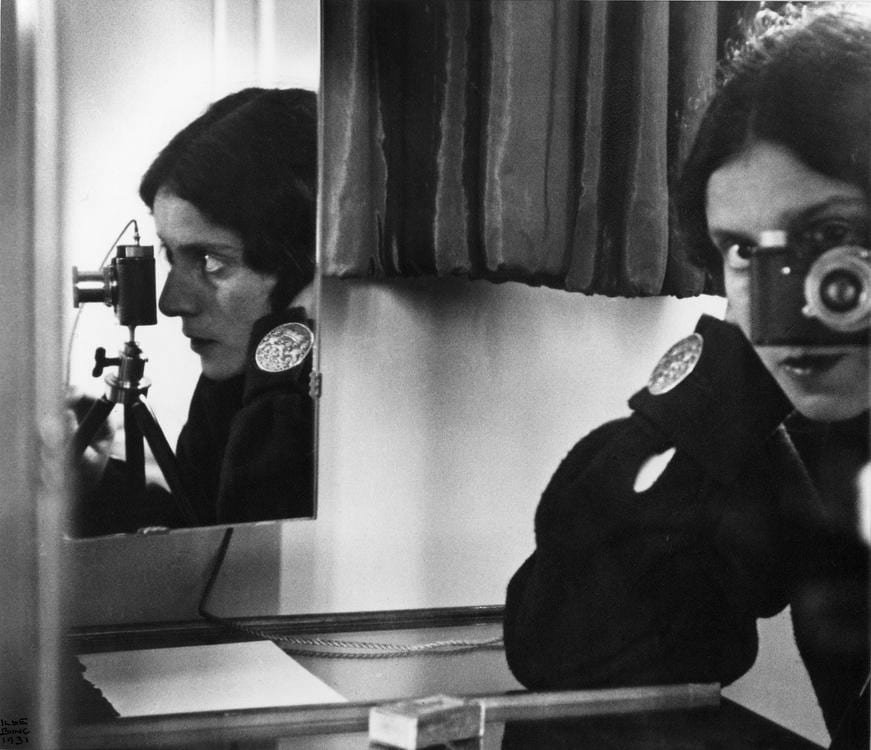As a member of Generation Z, I sometimes find it unfathomable that within my grandparent’s lifespan, photography was somewhat of a rarity, and from what they’ve told me, kind of a big deal. Over the course of one lifetime, photography has gone from a meticulously staged process to a rapid, one-button click of a cell phone. Alongside the rapidly advancing technological world, the exponential growth of photography prompted an immense shift in the practices of capturing images.
At the intersection of photography and this rapid technological growth lies the “mirror selfie.”

While the mirror selfie is not necessarily a new concept—pictured here, an early 20th-century box camera mirror selfie—readily available cameras have made the mirror selfie a daily occurrence. Most mirror photography that predates cell phone photography is seen in private settings such as the bedroom or studio. Today, mirror selfies happen just about anywhere and everywhere a mirror is present.
The more we see something, the less special it becomes. By the looks of it, that may be happening with mirror portraiture. There was a time when snapping film camera mirror photos was a cutting-edge trend, but today, everyone takes them. It seems artists are doing mirror self-portraits less and less because they are not as exciting anymore, they are no longer deemed “works of art.”

As we move farther and farther from the days when film mirror photographs were a hip, cutting-edge trend, it is important to take a moment to recognize some of the iconic mirror selfies to date—and see how they have influenced the mirror selfie trend thus far.
Ilse Bing, who later became known as the master of the handheld camera, shot this iconic mirror self-portrait in Paris in 1930. In addition to her trend-setting mirror selfies, Bing exhibited amongst some of the most well-known European photographers of the early 1930s. According to Holden Luntz Magazine, “The artfully staged “Self-Portrait in Mirrors” was taken in Bing’s room at the Hotel de Lôndres early in her evolution as an artist. In the image, Bing looks intently at her own reflection in a mirror, focusing her Leica at the same time on her reflection. A second mirror on the side shows her profile.”
HThe Norman Rockwell Triple Self Portrait (1972) is an introspective work combining elements of portraiture, photography, drawing, and art history. Rockwell skillfully depicted three different versions of himself through painting, drawing, and of course, a “mirror selfie.” There is something ephemeral about the portrait, as if Rockwell just sat down, painted these various versions of himself, and will soon flee the scene. Although before he flees, he will need to get the approval of portrait genius Rembrandt who is peering over his shoulder, perhaps guiding Rockwell through his paint strokes. While Rockwell does not quite perfect the mirror selfie, he does perfect the perspectives a mirror selfie only begins to achieve.
Barkley L Hendricks’ Portrait with black hat is a prime example of an iconic piece of photo history that may be a more common occurrence today. In 1980, it was progressive and a hot ticket item. Hendricks depicted himself, the artist, up close and personal through a beautiful film photograph. The portrait allows the viewer a glimpse into Hendricks’ process, and his method. Witnessing an artist in their studio, engaged in introspection creates a vulnerable and powerful message.


Each of these self-portraits feels deeper than what constitutes a mirror selfie today—they are set in an intentional space, planning was involved, and the setting is more private, thus allowing a glimpse into the lives of each artist. That is one thing our mirror selfie-crazed world shares with this past life of mirror portraiture—they all seem to take place in more intimate settings, allowing a glimpse into the personal lives of those behind the camera.
Even with these more modern examples of mirror portraiture, there seems to be a plan in place—the selfie is not taken haphazardly. So, does it become a portrait once a nice camera is involved? Or perhaps when it is not ‘recreational’ but more of an artistic approach is attempted? Who knows.
What we do know is that mirror selfies were influential in film photography and have become an integral part of our modern digital age. While at one point they worked for artists' introspective pursuits within a variety of art forms, today, mirror selfies offer a glimpse into the mundane or chaotic aspects of one’s life that we humans seem forever curious about. It seems the mirror selfie embodies an innate wish we all have to be seen and understood, and as technology advances, it will be interesting to see if the mirror portrait does with it.

©ArtRKL™️ LLC 2021-2023. All rights reserved. This material may not be published, broadcast, rewritten or redistributed. ArtRKL™️ and its underscore design indicate trademarks of ArtRKL™️ LLC and its subsidiaries.





